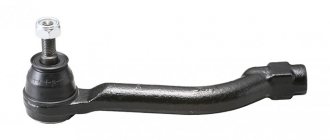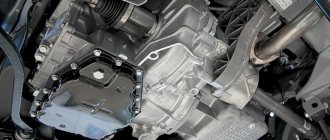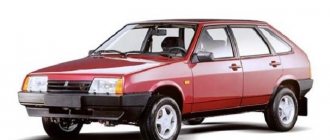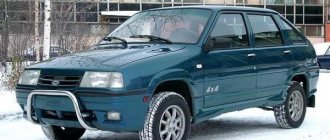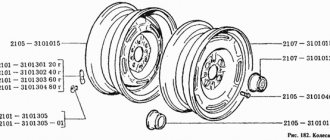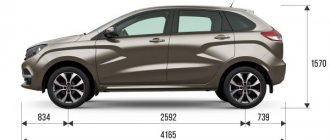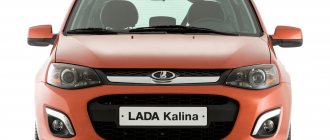On April 19, 1970, the first Zhiguli cars rolled off the main assembly line of the Volzhsky Automobile Plant. It was a VAZ-2101 model, popularly nicknamed “kopeyka”. After it there were five more models from the “classic” series, one Oka, a dozen Ladas. All these cars are not twins at all. Each VAZ has significant differences that are worth clearly seeing.
- Oka (1987—2008)
- LADA Samara family
- Family "ten"
VAZ-2110 (1995–2010)
- VAZ-2111 (1997–2010)
- VAZ-2112 (1998–2008)
- VAZ-1117 (2004–2018)
Classic Lada
The classic Zhiguli family consists of seven models of rear-wheel drive small class cars. There are two body types in the lineup - a four-door sedan and a five-door station wagon. All models are distinguished by a laconic design - now the appearance of Ladas may seem rustic, but for their time classic VAZs were quite stylish Soviet cars.
This infographic shows how the appearance of AvtoVAZ cars has changed from 1970 to 2022
VAZ-2101 (1970–1988) - the foreign public knew the model as LADA-120. It is a four-door sedan. The “penny” took away all external features from its Italian counterpart:
- cubic body shape (still with rounded corners, while subsequent models will become more “chopped”);
- a simple “facade” with a rectangular grille and a round pair of headlights;
- high roof line;
- rounded wheel arches;
- a laconic “rear” with vertically oriented lights and a small trunk lid.
The prototype for the first VAZ was the Fiat 124 (and quite legally, since an agreement was signed between the owner of the Italian concern and the Soviet Vneshtorg)
VAZ-2102 (1971–1986) - the five-door station wagon turned out to be spacious. In addition to the changed body type, the “two” is distinguished from the “kopek” by the license plate located on the fifth door and vertical rear lights.
The trunk of the VAZ-2102 could accommodate a lot of luggage (therefore, the car was the dream of every Soviet summer resident, fisherman, hunter and tourist)
VAZ-2103 (1972–1984) - the third model of the Lada (Lada 1500 in the export version) was launched from the assembly line in the same year as the “two”. The three-ruble note can be easily distinguished from the VAZ-2102, since they have different body types. But the large radiator grille with twin headlights “sitting” directly on it will help distinguish the VAZ-2103 from the previous sedan (“penny”).
Over 12 years, 1,304,899 of these Zhiguli “three rubles” were produced
VAZ-2104 (1984–2012) - station wagon, known in the West as Kalinka. The main difference from its predecessors is not round, but rectangular headlights. The lines of the body are more chopped (the roundings at the corners have become less pronounced than, for example, the “kopek”).
This five-door car demonstrates the classic Zhiguli design; The VAZ-2106 is larger than the “two” - it is 42 cm higher, and the luggage compartment is 112 cm longer
If the VAZ-2104 is the first domestic station wagon with rectangular headlights, then the VAZ-2105 is the first sedan with a similar form of optics. The body of the “five” is distinguished by its greater angularity. On the side there are wings with cut contours. The roof does not have a hint of rounding, the hood and luggage compartment are longer than those of a “kopek” or “troika”.
Export cars were called LADA-2105 Clasico; Soviet car enthusiasts nicknamed the car “stool”; “five” was liked by Soviet citizens who did not want to buy a station wagon, but wanted to have a car with a spacious trunk
VAZ-2106 (1976–2006) - popularly nicknamed the “Lada Six”; for foreign buyers the name Lada 1600 was used - a rear-wheel drive four-door sedan. A special feature of the VAZ-2106 is a round pair of headlights, “planted” not on the radiator grille, but in black plastic rectangles.
The VAZ-2106 became the most purchased car of the seventies and eighties in the USSR (in total, over 4.3 million “sixes” were produced and sold, while “threes” produced 1.3 million copies, and “fives” - 1.8 million)
VAZ-2107 (1982–2012) was made in accordance with the automotive trends of the eighties. At that time, angular, even slightly rough shapes, an abundance of chrome parts, and protruding parts (like the radiator grille, which began to protrude from the level of the hood) were fashionable. Like the VAZ-2106, the headlights are set in plastic rectangles (the difference is that the “six” has round front optics, while the “seven” has rectangular ones).
American automobile journalist Jeremy Clarkson, reviewing the VAZ-2107, called the car “a car for rude men who cannot tolerate anything feminine”
External differences between models
- The “Seven” has a chrome radiator grille, while in the VAZ 2105 it is made of black plastic. For practical drivers, the second option will seem the best, since if you frequently use the services of a car wash, the grille of the “Seven” will very quickly take on a not the most presentable appearance, since it is susceptible to corrosion and delamination of the chrome coating.
- The “Seven” has a wider “range” of instruments: a tachometer, an econometer, a center console with an output for a radio and a clock. The “Five” can only boast a socket for the radio, which is located under the front panel, and access to it is a little difficult.
- The trunk lid of the “five” has indentations, while on the “seven” it is absolutely straight and smooth.
- The structure of the taillights is different.
- The front seats are equipped with comfortable headrests, which is typical for the “Seven”.
Oka (1987—2008)
VAZ-111 (Lada Oka) is a Russian ultra-small class car. About 700 thousand models were rolled off the assembly line. The body type is a three-door hatchback. In an effort to reduce the size of the car, the developers sacrificed the harmonious appearance, which is why Oka was popularly nicknamed “Cheburashka”. Characteristic appearance features:
- miniature body;
- angular lines;
- rectangular optics;
- bumper made of unpainted plastic;
- shortened overhangs;
- short wheel arches;
- roof pillars too thin;
- large glass area.
Oka is 3200 mm long, 1420 mm wide, 1400 mm high
Life after graduation
In 2002, Ivan Dykhovichny shot the comedy film “Kopeyka”, in which a car becomes a time machine, reflecting the life of an entire generation.
On June 7, 2004, the grand opening of the world's first and only Monument to the “Kopeyka”, the popular VAZ-2101 car in Russia, took place.
A 1971 VAZ-2101 car prepared by the CityMotorsport team took part in the race of historical cars held at the prestigious Nürburgring track on October 1, 2004. Kopeyka's rivals were about 50 legendary racing cars of yesteryear. At first, our compatriot lost, mainly due to the low engine power, but after the rain began, the art of control began to play a big role. As a result, the VAZ-2101 crew finished in thirtieth position and first place in the class.
LADA Samara family
In 1984, the Volzhsky Automobile Plant decided to carry out a complete restyling of its VAZs and released the Lada Samara (aka VAZ-2108). In 1987, another model of this family was presented to the public - the VAZ-2109. The differences between the Samara and the classic Zhiguli were colossal, which divided Soviet citizens: some were outraged by the changed appearance of VAZs, others praised the manufacturers for innovations that separated domestic cars from the progenitor Fiat 124.
Initially, in the domestic market this line of VAZs was called “Sputnik”, and the name Lada Samara was used only for export cars
VAZ-2108 (1984–2003) - the three-door hatchback VAZ-2108 was popularly nicknamed “chisel” and “crocodile” for its elongated, narrowed front part. The car is spacious, as it was intended to be used as a family car. The body of the Samara is more rigid and, accordingly, safer than the “classics”. The rear seats are made with children in mind, and the trunk is spacious.
For the first time in the VAZ model range, VAZ-2108 began to be painted with metallized enamels in mass production
The VAZ-2109 (1987–2004) differs from the VAZ-2108 in that it is a five-door rather than a three-door hatchback. There are no other significant differences in appearance.
The width and length of the VAZ-2109 are the same as those of the VAZ-2108, and the height is an insignificant 4 cm greater
Technical characteristics of the “five” and “seven”
- The VAZ 2107 has a slightly different ventilation system (cold air deflector): air is taken in directly, not through the heater radiator. In the VAZ 2105, ventilation is carried out through the “stove” radiator.
- Some models of “fives” and “sevens” of different years of production have differences in engine power: 77 horsepower for the 2107 and 69 “horses” for the “five”.
- The piston stroke and cylinder size are also different: 66x79 in the “five” and 80x76 in the “seven”.
- Acceleration time to 100 km/h. The VAZ 2107 accelerates from a standstill in 15 seconds, and the 2105 in 18 seconds.
This is probably where the differences end; then we can only talk about the similarities:
- both models have rear-wheel drive;
- body type and number of seats, permissible additional trailer weight and braking distance, gearbox and steering mechanism, fuel tank and suspension, battery, generator and starter are absolutely identical for both models.
Appearance of headlights of models
VAZ is somewhat superior to other domestic car brands: their models have always been distinguished by the reliability and wear resistance of components, the relative cheapness of parts, spacious interior, and height (which is especially important for domestic off-road use).
Family "ten"
In 1983, the design of a sedan based on the VAZ-2108 hatchback began. The project received the code name “family of ten”. The VAZ-2110 was released first, then the VAZ-2111 and VAZ-2112 station wagons went on sale.
VAZ-2110 (1995–2010)
VAZ-2110 - four-door front-wheel drive sedan
VAZ-2010 (LADA 110) is a four-door front-wheel drive sedan. It was distinguished by its “biodesign”, fashionable for the mid-1990s, with smooth outlines and maximum glazing area.
The VAZ-2110 has fairly large rear wings, but the car does not seem heavy due to the reduced size of the bumper
VAZ-2111 (1997–2010)
VAZ-2111 is a station wagon that is valued for its spacious luggage compartment with a wide opening.
In the front part, this model completely replicates the VAZ-2110.
The VAZ-2111 five-door sedan has a spacious trunk
VAZ-2112 (1998–2008)
VAZ-2112 (aka LADA 112 Coupe) - this hatchback is a symbiosis of the VAZ-2110 and 2111
It's just as roomy as a station wagon, but the model's appearance is lightened by the sharp transition from the roof to the tailgate. There are no corners, all lines are very smooth.
The body length of the VAZ 2112 is less than that of the VAZ-2110, but the capacity is greater (due to the increased luggage compartment)
LADA Kalina
Kalina are front-wheel drive cars of the “small class II group” (segment “B” by European standards). The family includes a sedan, a five-door hatchback and a station wagon. These three VAZs became the first AvtoVAZ “projects” developed using computer technology.
VAZ-1117 (2004–2018)
VAZ-1117 or LADA Kalina 1 - five-door station wagon
It has a narrowed front and a powerful rear with a large trunk lid. But the transitions between different parts of the car are smooth, so the car as a whole looks harmonious.
Lada Kalina has a shorter length and width than Lada Samara, therefore it has better maneuverability and is more suitable for driving on busy city roads
VAZ-1118 (2004–2013)
Lada Kalina Sedan seems small, but this is an optical illusion, since the dimensions are identical to 2117
VAZ-1118 (LADA Kalina sedan) seems smaller than a sedan, but this is an optical illusion, since their dimensions are the same. The front end can be called aggressive due to its predatory tapering headlights and narrow radiator grille. But the bumper is very neat, which makes the car light.
The rear of this model looks inconspicuous, as the only thing that can be distinguished from it is the massive trunk lid
VAZ-1119 (2006–2013)
The body of the VAZ-2119 is designed in the same style as that of the VAZ-1117
VAZ-1119 or LADA Kalina hatchback - the body of this model is designed in the same style as the VAZ-1117. The bumper is round in shape, the trunk lid is small and has a maximum glass area. The rear lights are arranged vertically and are more elongated in shape than those of the station wagon and sedan.
This model seems to be the neatest among its brothers in the LADA Kalina family, although its length is only 190 mm shorter, and there are no differences at all in width and height
LADA Granta
Lada Granta is a domestic front-wheel drive car, developed on the basis of LADA Kalina. The developers were given the goal of making a car that would be as close as possible to the Kalina in technical parameters and appearance, but to reduce its cost. The desire to reduce the cost undoubtedly affected the appearance of the car.
LADA Granta sedan differs from Kalina in how the car looks from the front. The front part features a stylish “pattern” of headlights, radiator grilles, license plate and logo sign. These elements are placed on a black backing in the shape of the letter X. From the side and rear, Granta repeats the LADA Kalina sedan.
Granta's trademark is the black X in the front of the car - it houses slanted headlights, a large brand logo and chrome “boomerangs” that visually unite the radiator and lower grilles
In 2014, production of Lada Granta Liftback began. Like the sedan, the liftback has an X-shaped design at the front. In addition, the model is distinguished by a convex roof, smoothly turning into a miniature rear part.
At the rear of the liftback are small horizontally elongated lights, a large fifth door and a bumper with a black insert stylized as a diffuser.
LADA Granta sport (2018 to this day) is a front-wheel drive sedan of the “subcompact” category. It is not particularly spacious, nor is the liftback. During its development, the emphasis was placed on modern dynamic design, aimed at a youth audience. A voluminous bumper, a wing on the trunk lid and massive 16-inch wheels with a large number of small spokes give it a sporty look.
LADA Granta sport (2018 to this day) - front-wheel drive sedan of the “subcompact” category
Characteristics of VAZ
Description of the VAZ car
The history of the creation of the Volzhsky Automobile Plant (VAZ) goes back to 1967. The first production of cars was scheduled for 1971. The VAZ car was conceived as a Soviet people's car, which would be produced at a price acceptable to the people, and would be able to satisfy the demand in the USSR automobile market. Of course, it was not possible to make a car accessible to everyone, since with the creation and production of each new model the price increased. But at the same time, the problem of meeting demand in the auto market was quickly resolved. And in 1977, a new model NIVA was launched onto the production line.
In the early 80s, mass production of cars for export under the name Lada began. During the period from 1967 to 1991, VAZ produced 9 versions of the Zhiguli model. And model 2102 has become the best of its kind, for those who like to relax in the country or people engaged in small trade. This model was replaced by the 2106, which was replaced by the 2110.
2106 was named the best model from the entire Zhiguli model range. And in 1976, already at the plant in Tolyatti, it was put on a mass production line.
Another epic car was the Soviet SUV NIVA, which became a sensation on the global automobile market in the 70s. This car was given a medal of honor and well-deserved recognition at the International Exhibition in 1980.
After the collapse of the USSR, the VAZ automobile concern found itself in a severe crisis, since with the beginning of perestroika, it was necessary to completely rebuild the sales and production policy at the factories. But already in 1995 the world saw a new model 11113, called OKA. To this day, OKA is the cheapest domestic car, as it was even called the new people's car.
Today, VAZ is at the stage of cooperation with Opel AG, and is producing the latest Opel Astra model. VAZ is engaged in the production and production of more than 50 percent of Russian passenger cars.
Lada 1117 Kalina is a five-door class “B” station wagon, which is a model of the Lada Kalina family of cars.
Lada Kalina has an elegant design and a dynamic interior with innovative technical developments. The improved interior design has original lighting, and is perfectly suited for driving around the cities of Russia and Ukraine. The Lada Kalina car is very easy to drive and easy to use. It can deservedly be called one of the best cars in its model range. Of course, VAZ is a concern that cares about safety, therefore, the Lada Kalina meets all technical characteristics and also provides increased passenger safety.
Lada Priora is a project that was presented to the general public in 2003 at the Moscow Motor Show. This is an improved car, which was developed on the basis of the VAZ 2110.
The Lada Priora (Lada 2170) car with a sedan body is made in the classic VAZ style, but at the same time emphasizes solidity and looks larger than it actually is. The design of the car is completely new, it was carried out by leading designers and constructors of the Russian automobile concern VAZ. The public at the Moscow salon in 2003 appreciated the new, trendy design of the instrument panel, as well as the ease of control and operation.
Lada Priora is an excellent, worthy option for both price and quality, design and ease of use. It is also lightness, reliability and safety.
Lada Largus
In 2011, AvtoVAZ presented to the public the first model from the Largus family. It was a C-class car, the prototype for which was the Romanian Dacia Logan MCV 2006. The line includes a passenger station wagon and a van.
Lada Largus R90 (2012 to this day) is a passenger station wagon in 5- and 7-seater versions. Its design is simple, devoid of any decorations.
Many people think that Largus looks awkward, but the developers decided to sacrifice the lightness of its appearance for the sake of spaciousness and ease of use of the passenger part of the car.
Largus F90 (2012 to this day) is the same R90. Only instead of the passenger part there is a cargo compartment, which has blank rear and side panels on the outside. The rear hinged doors can be locked in three positions. The side doors provide a wide opening angle, so that unloading can also be done through them.
The rear of the van and the doors are designed to make loading and unloading even large items easy
Lada XRAY (2015 to this day)
LADA XRAY is a compact hatchback made in the style of an SUV (a sports-utilitarian car used daily and allowing it to accommodate a lot of cargo). The front bumper of the car is raised and has an X-shaped black pattern like the Lada Granta. A relief (stamping) appeared on the sidewalls, giving the car a dynamic appearance.
Appearance Lada XRAY has a rather aggressive look
The first AvtoVAZ car was rolled off the assembly line in 1970. Since then, the plant's designers have not been idle and are constantly coming up with new variations, focusing on the changing needs of society. The ancestor of the VAZ, the “kopek” has absolutely nothing in common with the modern Ladas Largus, XRAY, Granta.
